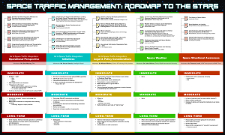Feasibility Modeling of a Space Plane Gliding into Congested Air Space
Abstract
Abstract
There is considerable interest in the development of spaceports and their integration into the National Air Space System (NAS). The return from orbit of a space plane and how it would interact with other traffic in the commercial flight environment is of special interest. This paper describes the creation by students and faculty at the Metropolitan State University of Denver (MSU Denver), Aviation and Aerospace Department, of a scenario in Analytical Graphics Inc. (AGI) System Tool Kit (STK) modeling software of such an event. Commercial companies that have vehicles with horizontal takeoff and landing capability currently use proprietary re-entry profiles. Due to the proprietary nature surrounding such vehicle data, we obtained from the National Aeronautics and Space Administration (NASA) the now retired Space Shuttle’s profile from a nominal orbital re-entry. Using STK, we integrated the space shuttle landing into a previously created project, which modeled two hours of Denver International’s Airport (DIA) actual early morning air traffic. This is the busiest time for DIA and included over 500 flights in this given scenario. The scenario included geographic information system (GIS) shape files of the various airspace classes up to 14,000 feet and a model of Front Range Airport, which was to be the landing target for the space shuttle. The software was programmed to create a proximity bubble around the Space Shuttle that would alarm if any aircraft approached within 5 miles. Initial analysis of this one-time scenario event showed positive results with only one aircraft touching the proximity bubble.
Feasibility Modeling of a Space Plane Gliding into Congested Air Space
Abstract
There is considerable interest in the development of spaceports and their integration into the National Air Space System (NAS). The return from orbit of a space plane and how it would interact with other traffic in the commercial flight environment is of special interest. This paper describes the creation by students and faculty at the Metropolitan State University of Denver (MSU Denver), Aviation and Aerospace Department, of a scenario in Analytical Graphics Inc. (AGI) System Tool Kit (STK) modeling software of such an event. Commercial companies that have vehicles with horizontal takeoff and landing capability currently use proprietary re-entry profiles. Due to the proprietary nature surrounding such vehicle data, we obtained from the National Aeronautics and Space Administration (NASA) the now retired Space Shuttle’s profile from a nominal orbital re-entry. Using STK, we integrated the space shuttle landing into a previously created project, which modeled two hours of Denver International’s Airport (DIA) actual early morning air traffic. This is the busiest time for DIA and included over 500 flights in this given scenario. The scenario included geographic information system (GIS) shape files of the various airspace classes up to 14,000 feet and a model of Front Range Airport, which was to be the landing target for the space shuttle. The software was programmed to create a proximity bubble around the Space Shuttle that would alarm if any aircraft approached within 5 miles. Initial analysis of this one-time scenario event showed positive results with only one aircraft touching the proximity bubble.


